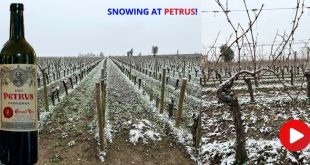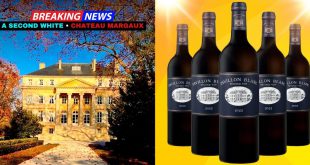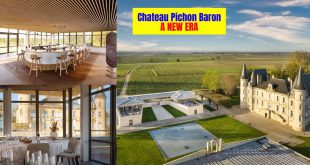

When Sandrine Garbay joined Chateau d’Yquem straight from the University of Bordeaux in 1994, she was never, ever going to use the specialised subject of her doctorate thesis: malolactic fermentation. The world’s most famous sweet wine would never consider converting malic into lactic acid because it thirsts for freshness. Yquem hired Garbay because she is just so exceptionally brilliant.
In the summer of 2014, I travelled with Garbay for a week in China (where I helped pair five vintages of Yquem with Chinese dishes in five different cities). At the time, I had known Sandrine for 15 years and she had always come across as a down-to-earth, unassuming, friendly and incredibly humble luminary of Bordeaux winemaking. During our conversations, I was awestruck by one particular characteristic of the Frenchwoman. Yquem’s head winemaker was always referring – and deferring – to what she had learned from others rather than trying to impress with what she knows. If anyone has any bragging rights, Sandrine Garbay should be right in front of the line as she is the Maitre de Chai of the highest classified wine of the 1855 classifications of the Médoc and Barsac & Sauternes.
We often forget that in 1855 there were two classifications, not one, and that it was lopsided at the top of those two league tables. So, while there were only four First Growths in the Médoc (Haut- Brion, although in the Graves, was simply too wonderful to be ignored), there were 11 in Barsac and Sauternes. Even more sweet was the supreme honour bestowed on a Sauternes estate. Already geographically at the highest point of the commune – 85 metres above sea level – Yquem soared over the 1855 classifications by being named the one and only Premier Cru Supérieur. Fast forward 165 years later and Yquem still has no equal. But the wine – both the dry Ygrec and the sweet Yquem – has changed considerably in the time Garbay – who was promoted to Maitre de Chai in 1998 – has been there.

Sandrine Garbay joined Yquem straight out of the University of Bordeaux. Her Ph D thesis was on malolactic fermentation, something which will never be visited on the Sauternes. The French lady is the only woman Maitre de Chai of a First Growth in Bordeaux, not just any Premier Cru but Yquem.
The first change for Ygrec took place in 1994 when Garbay was assistant to then cellarmaster Guy Latrille (he retired in 1997, after 45 years at the estate). Prior to 1994 (the previous vintage being 1988), Ygrec was fermented and aged entirely in new oak for 18 months, a process unchanged since its first vintage in 1959. Not to mention that the grapes – Sauvignon Blanc and Semillon – were quite rotten (nobly of course) before being transformed into a dry wine.
‘In 1994, we decided to give Ygrec more fresh fruit, acidity, freshness and balance, and for the first time we harvested the grapes – both Sauvignon Blanc and Semillon – without botrytis,’ Garbay informed.
Ygrec 1994 continued to be fermented and aged entirely in new oak for 18 months. The end result was still not entirely satisfactory. ‘The wine lacked something,’ she said, adding ‘It did not have a link with Yquem. Previously, Ygrec had the nose of noble rot but the palate was dry. We felt we had to harvest some of the grapes in over-ripe conditions to maintain the link.’
That opportunity came in 1996 when the fruit was harvested after having been infected by botrytis. But, for the first time, the amount of new oak was dropped to just one-third, with the rest in barrels that had been used previously to hold Yquem. Although only six barrels were produced, Ygrec 1996 was considered much better than 1994. There was then no Ygrec until 2000, which was produced much the same way as 1996. Then in 2004, Pierre Lurton, Yquem’s president, made the decision to produce Ygrec every year. In 2005, it was decided that the Semillon (now comprising about 30% of the blend) would be harvested when it was just slightly botrytised – the skin turning a pink blush – and the Sauvingon Blanc not at all.
The proportion of new oak has also been progressively reduced, as has the time the wine spends in wood. Indeed, in 2010 Garbay decided to age the entire vintage of Ygrec in used one year-old oak. The unprecedented restraint drew a disappointed reaction from the barrel suppliers. It prompted one of the coopers, Seguin Moreau, to recommend a speciality of theirs: oak staves from the acacia tree. Ygrec 2011 was the first vintage to be fermented and aged in some of these, where the head and bottom of barrels are made from staves of the flowering tree. ‘They don’t impart a floral taste as such, but have the virtue of keeping the fruit and freshness of the wine,’ Garbay said.

The new reception at Yquem.

Today, Ygrec – or just ‘Y’ on the label – is aged 10 months in 20% new barrels and the balance in one-year-old wood that had previously held Yquem. Of the 7 grams of residual sugar in Ygrec, 3 gm is leeched out of the Yquem seasoned barrels. As for Chateau d’Yquem, the biggest change came from the 2002 vintage onwards when fermenting and then ageing in new oak for 36 months was reduced to just 20. The world’s most famous sweet wine is flushed with layered rich fruit held in a ring of encircling, unforgiving freshness.
All through her undergraduate and postgraduate studies, Sandrine Garbay lamented the fact that her birth vintage, 1967, was not a good one for the wines of Bordeaux – until she landed her first job. When she arrived at Yquem she was told of the legendary 1967 wine, one of the greatest Sauternes of all time. The then 27-year-old saw that as fate and destiny. Within a year, she got her chance to taste the golden wine.
Life doesn’t get any sweeter than that.


